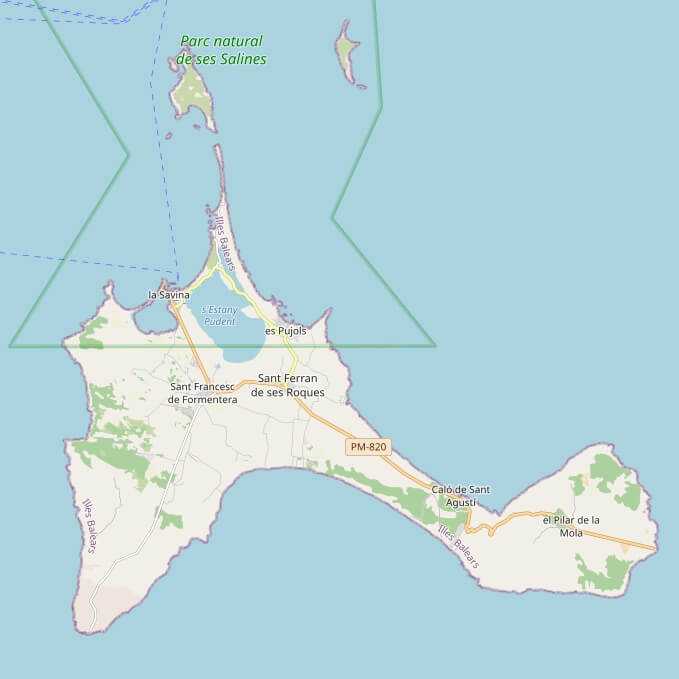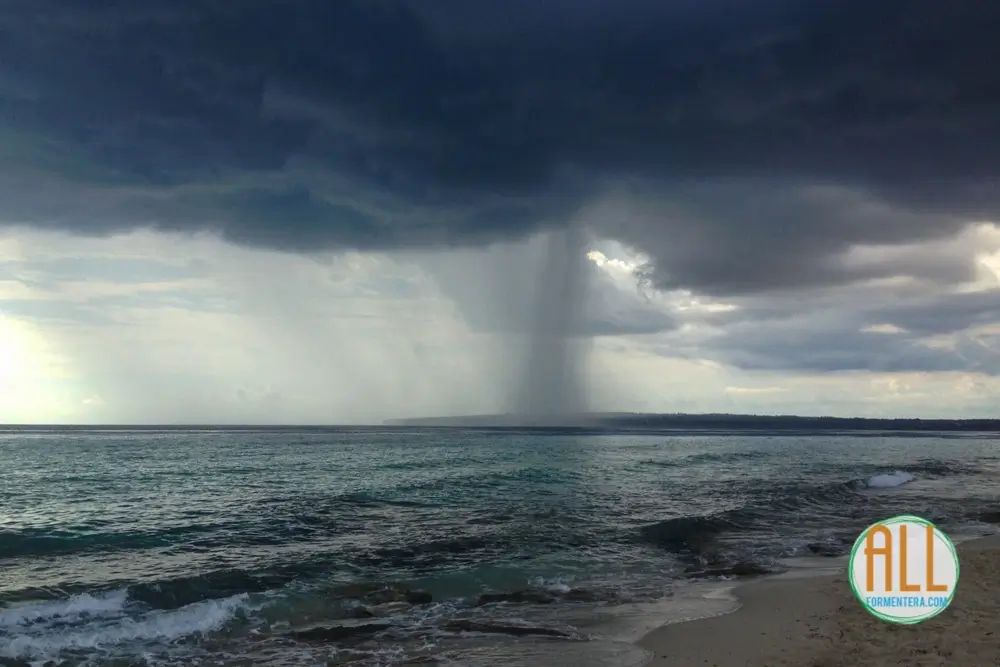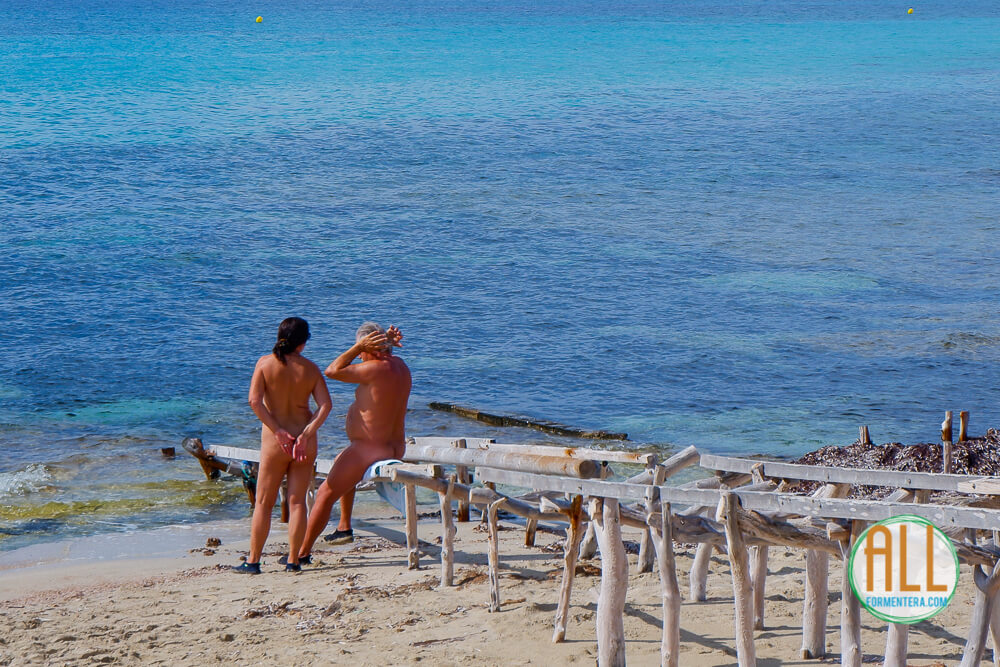Geographical location
Formentera is the southernmost and smallest of the four inhabited islands that make up the Balearic Mediterranean archipelago: Menorca, Mallorca, Ibiza and Formentera.
Formentera is located south of the island of Ibiza, territorially separated from it by about 3km, although the distance between the ports of both islands is about 20 kilometers. Ibiza, Formentera and several uninhabited islets form the archipelago of the Pitiusas islands.
The closest continental point to Formentera is the city of Denia, in the Autonomous Community of the Valencian Country, in Spain. Denia is 100km away in a straight line to the west.
Formentera stands out for its beautiful beaches and charming spots where people can nudist, swim, explore, snorkel and enjoy the culture and gastronomy of the region.
Moreover, it is a privileged island that does not suffer from dangerous weather events apart from the occasional summer storm or winter storm that can close maritime traffic for a few hours or a couple of days.
Map of the island of Formentera
Getting to know all the regions, towns, beaches and attractions of this tropical paradise is very easy by following the map of the island.

On our website you have an interactive map with individual tabs of each place with all the information of the island, services, beaches…
Check out the map here:
Description of Formentera
What is Formentera like, how is it organized politically and how many inhabitants does it have?
Geographic Description
Formentera is a small island, 15 x 13 km, predominantly flat. It can be crossed from end to end by vehicle in just 20 to 30 minutes.
The highest point of the island is about 190 meters above sea level in the area of La Mola, and much of the coast (about 25 km of the 70 km it has) are beaches and areas accessible for swimming. The rest are rocky areas and cliffs.
The low coastal areas with beaches are mostly sandy areas and coastal dunes in an excellent state of conservation, with unique flora and fauna endemic to the Pitiusas Islands.
If we talk about dunes and sandy areas, the most popular beaches are those of Cala Saona, ses Illetes and some areas of Migjorn, such as Es Arenals and Es Copinyar, as they are easily accessible and ideal for families with children.
On the other hand, apart from the beaches, the coves are also very characteristic of the island of Formentera, although some of them are not very visited because they are in areas of difficult access or with rocks.
In its geography it is important to mention the islets located to the north: Espalmador Island stands out in particular. A little further east is the islet of Espardell, where there is one of the most beautiful dives in the Balearic Islands: the platform.
Administrative Description

Formentera is both an island and a municipality in itself. This means that it has its own governing bodies with autonomy for the administrative management of the resources and needs of the island’s population.
There are currently about 12,000 inhabitants on the island, although the number of people present on the island quadruples that figure during the summer months. Specifically, in 2021, this island paradise had a population of 11,708 inhabitants, which according to the censusIn the case of the other 5,587, 6,121 are men and the remaining 5,587 are women. The capital and the largest and most important urban center is Sant Francesc, home to some 3,000 people.
Towns on the island of Formentera
There are 6 towns that make up the island and offer a diversity of attractions, such as beaches, forests, towers, playgrounds, coves, churches and unique flora and fauna. These towns are the following.
The Pillar of La Mola

Pilar de la Mola is the most remote village of the whole island, located at an altitude of about 130 meters above sea level, on the eastern plateau of the island. This isolation from the rest of the island makes Pilar de la Mola also the quietest village of all the villages of Formentera.
The village of El Pilar dela Mola developed around the 18th century church. The urban center is very small and most of the population is scattered in the surrounding area.
La Mola is well known and frequented especially on Wednesdays and Sundays, the days when the well-known La Mola Market is held.
Es Caló

Es Caló is a small village of only 3 streets, which developed from the pier known by the same name. Es Caló was for many years a fishing village, where the people of the sea of Formentera sheltered the boats and repaired them. The small pier of Es Caló, naturally very protected from the sea, has been used since Phoenician times, 2,000 years ago, as we commented in our article History of Formentera. Nowadays, the use of the small houses of the pier is merely testimonial and to shelter mostly pleasure boats, although they are preserved in perfect condition.
The village is very commercial and you can see attractions such as the Castellum Romano de Can Blai and Ses Platgetes.
Es Pujols

Es Pujols is a beach town eminently touristic and developed from the expansion and economic opening of Formentera 50 years ago. It is the busiest, liveliest and noisiest of all the villages of Formentera, especially at night. Es Pujols is the favorite meeting point of the Italian community on the island and therefore most of the businesses and restaurants are run by Italians. The village is known for installing the Es Pujols flea market every night on the seafront promenade.
In it, you can also enjoy the beach of Es Pujols, the beach of Ses Canyes, the beach of Sa Roqueta, the tower of Sa Punta Prima and much more.
La Savina

La Savina is the gateway to the island. In La Savina is the port of Formentera, the only point of entry and exit of Formentera. The small town of La Savina is an urban nucleus that has been developing around the port.
In La Savina we mainly find services oriented to satisfy the needs of the people who disembark in the port: cab and bus stops, car rental services, accommodation and companies related to sailing and boats. There is also a daily flea market.
Sant Ferran

Sant Ferran is a small town located almost in the geographical center of the island. It does not offer tourist services as do, for example, La Savina or Sant Francesc and at first glance it looks like a purely residential village. However, at night there is a lot of movement of people who go to the restaurants or to the Sant Ferran Art Market.
Sant Ferran is the most hippy of all the villages of Formentera; in the square people usually gather to enjoy the cooler hours of the night and talk until the wee hours of the morning. Some of the most mythical bars and restaurants of the island are here: the best known of all is the Fonda Pepe, opened during the 60s.
Sant Francesc

Sant Francesc is the largest of all the towns, the one that concentrates more commercial and human activity and where the governing bodies of the island are located.
In Sant Francesc we can find a wide commercial offer, both tourist-oriented stores, as well as those more specialized and offering services for the permanent inhabitants. Because of its size and importance, Sant Francesc is considered the capital of Formentera.
In Sant Francesc, in addition to stores and services, there are also two street markets: the daily street market of Sant Francesc and the second hand market.
How does Formentera communicate with the world?
The connection between the island of Formentera and the world, as is obvious, is possible only by boat.
The vast majority of ferry lines depart from Ibiza, where the vast majority of visitors to Formentera arrive via its airport. In summer another way to get to Formentera is through the ferry line that leaves from Denia, in the Valencian Community.
If you want to know all the options you have to get to Formentera take a look at our article:
A little history of Formentera
The first documented history of Formentera dates back to the Bronze Age, when Ca na Costa was built and discovered in 1974, a burial tomb dating from the period between 1900 and 1600 BC.

There is also documented human presence from this period thanks to the prehistoric huts of Cap de Barbaria. During the prehistoric and middle ages, the Phoenicians, Romans and Muslims also passed through Formentera.
Finally, Formentera as we know it began to be created after the conquest of the Balearic Islands by James I of Aragon, whose troops were led by William of Montgrí: he conquered the Pitiusas in 1235 and incorporated them into the Kingdom of Mallorca.
The difficult living conditions on an island with few resources, in addition to the black plague epidemics that devastated Europe, caused Formentera to go through periods of total depopulation.
In 1695 the final and definitive repopulation of the island by residents of Ibiza and population of northern Catalonia took place and in 1726 they erected the first church in the region: the church of Sant Francesc de Formentera, which was dedicated to San Francisco Javier. This church was also designed as a strong protection against pirate attacks.

From the 50s, 60s and 70s Formentera began a progressive process of economic opening based on tourism and the island began to receive visitors and to create the tourist model on which its economy is based today.
Today, the island does not depend on anyone for its economy, to the point of having its own Island Council, which can make decisions on administration and territory with a certain independence from Ibiza and the region’s capital, Mallorca.
If you want to learn all about the history of Formentera we leave you a very complete article:
Weather and climate in Formentera
The climate of Formentera is typical Mediterranean, with a low rainfall, more than 300 days of sunshine a year, dry and hot summers and mild winters.
In summer, for example, the temperature can easily exceed 30°C, ideal for bathers, and in the colder months, such as January and February, the maximum temperature may not reach 8/10°C.
Given the small size of the island and the absence of geographical features, the climate hardly varies from one area to another. What you can notice especially in summer are slight temperature changes between areas with different altitudes: if you move by bike or motorcycle you will notice these temperature changes caused by the channeling of cold air to the lower areas of the island. This phenomenon occurs at night hours after sunset, when the sun no longer heats the surface of the island. It is at this time that these exchanges are created between the warm air at the surface and the cold air coming down from the higher layers of the atmosphere.
In summer, especially after an episode of several days of heat, thunderstorms that suddenly discharge torrential rain are common.

Posidonia, a very abundant and vital underwater plant

Although we already mentioned it in our article on the flora and fauna of Formentera, posidonia is so important and benefits the island of Formentera so much that it deserves to have a whole section for it alone.
This plant is what ensures that the waters of Formentera are so clear, beautiful, clean, clear and have that beautiful turquoise color that distinguishes them and makes them so well known.
It should also be mentioned that each square meter of posidonia captures a lot of cO2 and produces a large amount of oxygen (more than a square meter of Amazon rainforest), which allows that with such oxygenated waters the marine life in the area is very abundant, rich and healthy.
Posidonia grows extremely slowly, no more than one centimeter per year, but in the meadow between Formentera and Ibiza there is an 8 km long specimen that is a single plant: this implies that the age of this plant is 100,000 years, yes 100 millennia.
In short, it is a key marine plant for the development of marine life and the quality of its waters.
If you want to learn everything about Posidonia Oceanica we leave you a very complete article:
Nudism on the island of Formentera
Where to do nudism on the island of Formentera and which are the best places?

Many tourists who visit this paradise surrounded by turquoise waters that is Formentera come to the island because they want to enjoy nudism in total tranquility.
And if you are a naturist or practice naturism or nudism you will surely know that the best areas to practice it are those little crowded, without bustle, noise or crowds.
Therefore, the best beaches, coves and places to practice nudism in Formentera are the following:
- Levante Beach: it is located in the area of Illetas and is the largest beach of Formentera. It has an extension of 2000 X 20 meters, its waves are moderate, it has services and restaurants.
- Es Trucadors: it is the northernmost part of Illetas and measures 300X7-12 meters. It has calm waves, no services and the nearest restaurant is Restaurant Es Ministre.
- Ca Marí: it extends for 1300X10 meters, its waves are calm, it has services and has beach bars and restaurants.
- Es Mal Pas: it is very close to Ca Marí and is almost always half-empty. There are two beach bars in the area and it is one of the perfect places to enjoy Formentera without clothes.
If you want more information about the best places for nudism in Formentera, take a look at this article:
The fauna and flora of the island of Formentera
Formentera has a typical Mediterranean fauna and flora, with some adaptations and differences in some animals and plants that are unique to this island.

The flora of Formentera consists of Mediterranean plants well adapted to the island’s climate. The most abundant trees are pines and junipers, plant species adapted to the demanding climate: intense heat and scarce rainfall.
There are also small plants adapted to this climatic regime, such as sea holly, rosemary, thyme, cactus, junipers, junipers, junipers, pines, bougainvillea, fig trees….. There are some wooded areas on the island, especially noteworthy those of Cala Saona, the pine forest of La Mola -with very tall and leafy trees and that we crossed just before entering the village of El Pilar- and the whole area around the nucleus of Es Caló, where the forest covers most of the land in this part of the island.
Speaking of its fauna, you can see more than 210 types of birds, including lizards endemic to Ibiza and Formentera, rabbits, mice, hedgehogs, bats and much more.
Here we talk more in depth about the flora and fauna of Formentera:
The beaches of the island of Formentera
The island of Formentera has more than 20 beaches for residents and tourists to enjoy pleasant bathing during the hottest days of the summer.
However, not all of Formentera’s 70 kilometers of coastline are sandy beaches. Most of them (about 45 kilometers) are rocky areas or cliffs over a hundred meters high. However, the 25 kilometers that do allow swimming are simply spectacular.
The waters of Formentera have nothing to envy to some of the most stunning beaches in the world, whether in the Caribbean Sea or the Indian Ocean.
The beaches of Formentera are mostly south, east and west facing: in the case of the latter, they offer a very romantic sunset.
Some of the beaches are surrounded by cliffs or rocks, which makes them ideal to enjoy privacy and nudism or also to enjoy a day of snorkeling.
The impressive colors and transparency of the waters of Formentera are achieved thanks to the excellent state of conservation of the submerged ecosystem that surrounds the island: the Posidonia Oceanica meadows, which keep the waters clean, oxygenated and protect the coast and beaches from erosion and sea storms. The spectacular and unique nature of this environment has led to the Natural Park of the Salt Flats of Ibiza and Formentera being listed as a World Heritage Site by UNESCO for more than 20 years. On the web we have all the information and descriptions you need about the beaches of Formentera.
Here you have a complete list of the beaches of Formentera:
The island of Formentera in winter

Strolling through the streets of the island, hiking in the parks, green trails, kayaking, visiting the cave of Barbaria… are perfect activities for the winter.
Although the temperature drops a little during the winter months, the sunny days are perfect to enjoy the totally empty island of Formentera.
If you want to know what to do in Formentera in winter, we have an article dedicated to it:
What to expect from your visit to Formentera?
Formentera is an island that has managed to maintain the integrity of its territory thanks to a population that has always known how to value the uniqueness of a very peculiar territory. For example, the people of Formentera have been combative and have taken to the streets on more than one occasion to defend their island from urban development projects that they considered unconscionable, such as the construction of a campsite in the Ca Marí area or an urban development project in the surroundings of Estany des Peix.
Although evidently the island has had to adapt to the current times and the arrival of more and more tourists, with the consequent escalation of prices, the difficulties to find long-term housing and other problems inherent to areas with high tourist pressure, Formentera has managed to maintain the essence of its territory much better than other places that have lost it.
In Formentera you will not find big buildings, skyscrapers or traffic lights. There are no nightclubs with a capacity for 8,000 people where the most famous DJ’s on the planet play.
Most of the access roads to the beaches are unpaved, the island’s coastline has not been modified to build a macro hotel complex or a promenade, the beaches are all natural and there are no areas or neighborhoods that can be considered unsafe.
What you will find, especially if you visit in July or August, are crowds on the beaches, in the streets of the different towns and waiting lists for dinner in most restaurants on the island. If you come to Formentera do it to enjoy spectacular beaches and waters, a gastronomy that is increasingly at a higher level and easy access to all areas of the island by car, motorcycle or bicycle.
You have reached the end of the article. Other sites that may interest you are:









